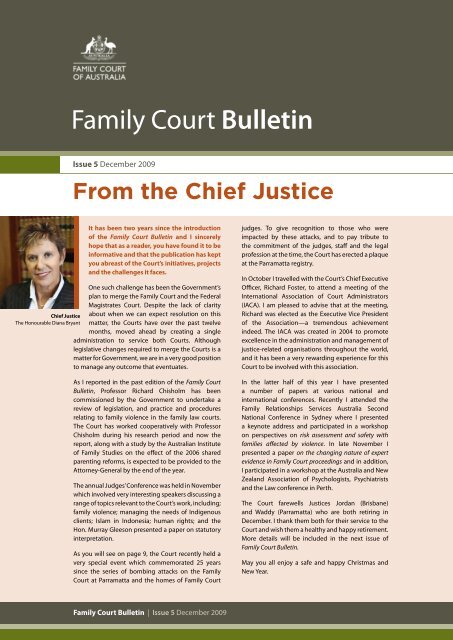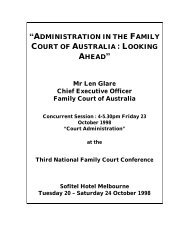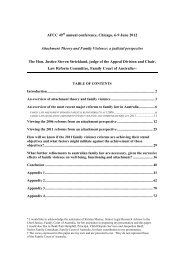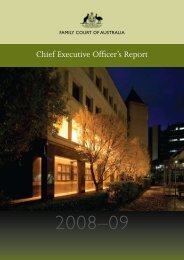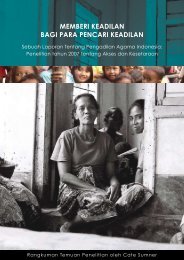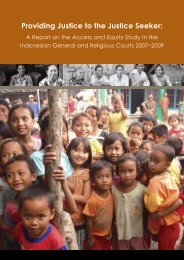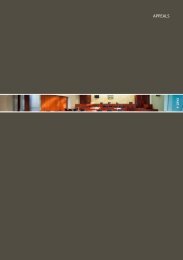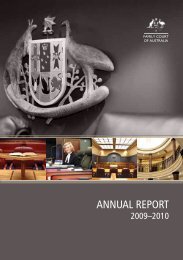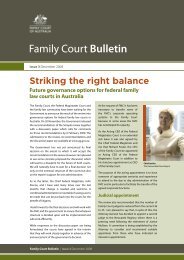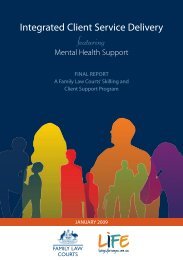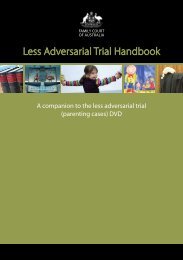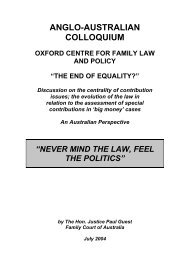Open PDF - Family Court Bulletin - December 2009 - Size 482 KB
Open PDF - Family Court Bulletin - December 2009 - Size 482 KB
Open PDF - Family Court Bulletin - December 2009 - Size 482 KB
You also want an ePaper? Increase the reach of your titles
YUMPU automatically turns print PDFs into web optimized ePapers that Google loves.
<strong>Family</strong> <strong>Court</strong> <strong>Bulletin</strong><br />
Issue 5 <strong>December</strong> <strong>2009</strong><br />
From the Chief Justice<br />
It has been two years since the introduction<br />
of the <strong>Family</strong> <strong>Court</strong> <strong>Bulletin</strong> and I sincerely<br />
hope that as a reader, you have found it to be<br />
informative and that the publication has kept<br />
you abreast of the <strong>Court</strong>’s initiatives, projects<br />
and the challenges it faces.<br />
One such challenge has been the Government’s<br />
plan to merge the <strong>Family</strong> <strong>Court</strong> and the Federal<br />
Magistrates <strong>Court</strong>. Despite the lack of clarity<br />
Chief Justice about when we can expect resolution on this<br />
The Honourable Diana Bryant matter, the <strong>Court</strong>s have over the past twelve<br />
months, moved ahead by creating a single<br />
administration to service both <strong>Court</strong>s. Although<br />
legislative changes required to merge the <strong>Court</strong>s is a<br />
matter for Government, we are in a very good position<br />
to manage any outcome that eventuates.<br />
As I reported in the past edition of the <strong>Family</strong> <strong>Court</strong><br />
<strong>Bulletin</strong>, Professor Richard Chisholm has been<br />
commissioned by the Government to undertake a<br />
review of legislation, and practice and procedures<br />
relating to family violence in the family law courts.<br />
The <strong>Court</strong> has worked cooperatively with Professor<br />
Chisholm during his research period and now the<br />
report, along with a study by the Australian Institute<br />
of <strong>Family</strong> Studies on the effect of the 2006 shared<br />
parenting reforms, is expected to be provided to the<br />
Attorney-General by the end of the year.<br />
The annual Judges’ Conference was held in November<br />
which involved very interesting speakers discussing a<br />
range of topics relevant to the <strong>Court</strong>’s work, including;<br />
family violence; managing the needs of Indigenous<br />
clients; Islam in Indonesia; human rights; and the<br />
Hon. Murray Gleeson presented a paper on statutory<br />
interpretation.<br />
As you will see on page 9, the <strong>Court</strong> recently held a<br />
very special event which commemorated 25 years<br />
since the series of bombing attacks on the <strong>Family</strong><br />
<strong>Court</strong> at Parramatta and the homes of <strong>Family</strong> <strong>Court</strong><br />
judges. To give recognition to those who were<br />
impacted by these attacks, and to pay tribute to<br />
the commitment of the judges, staff and the legal<br />
profession at the time, the <strong>Court</strong> has erected a plaque<br />
at the Parramatta registry.<br />
In October I travelled with the <strong>Court</strong>’s Chief Executive<br />
Officer, Richard Foster, to attend a meeting of the<br />
International Association of <strong>Court</strong> Administrators<br />
(IACA). I am pleased to advise that at the meeting,<br />
Richard was elected as the Executive Vice President<br />
of the Association—a tremendous achievement<br />
indeed. The IACA was created in 2004 to promote<br />
excellence in the administration and management of<br />
justice-related organisations throughout the world,<br />
and it has been a very rewarding experience for this<br />
<strong>Court</strong> to be involved with this association.<br />
In the latter half of this year I have presented<br />
a number of papers at various national and<br />
international conferences. Recently I attended the<br />
<strong>Family</strong> Relationships Services Australia Second<br />
National Conference in Sydney where I presented<br />
a keynote address and participated in a workshop<br />
on perspectives on risk assessment and safety with<br />
families affected by violence. In late November I<br />
presented a paper on the changing nature of expert<br />
evidence in <strong>Family</strong> <strong>Court</strong> proceedings and in addition,<br />
I participated in a workshop at the Australia and New<br />
Zealand Association of Psychologists, Psychiatrists<br />
and the Law conference in Perth.<br />
The <strong>Court</strong> farewells Justices Jordan (Brisbane)<br />
and Waddy (Parramatta) who are both retiring in<br />
<strong>December</strong>. I thank them both for their service to the<br />
<strong>Court</strong> and wish them a healthy and happy retirement.<br />
More details will be included in the next issue of<br />
<strong>Family</strong> <strong>Court</strong> <strong>Bulletin</strong>.<br />
May you all enjoy a safe and happy Christmas and<br />
New Year.<br />
<strong>Family</strong> <strong>Court</strong> <strong>Bulletin</strong> | Issue 5 <strong>December</strong> <strong>2009</strong>
Judgments of interest<br />
Marsden & Winch<br />
[<strong>2009</strong>] FamCAFC 152 (Bryant CJ, Finn and Cronin JJ), 26 August <strong>2009</strong><br />
This was an appeal by the father against the orders<br />
of the trial judge dismissing his application to obtain<br />
orders for face-to-face time with his ten year old<br />
daughter. Orders had been made in August 2006 that<br />
the father spend no time with the child and that the<br />
father’s contact be limited to written communication<br />
with the mother, who could then decide whether or<br />
not to pass letters on to the child.<br />
The father’s subsequent application for face-to-face<br />
time with the child was dismissed by the trial judge at<br />
a preliminary stage on the basis that the father had not<br />
established a sufficient change in circumstances as to<br />
warrant a re-hearing. On appeal, the father asserted that<br />
the trial judge had misapplied the ‘threshold test’ arising<br />
from Rice & Asplund, and in doing so denied the father<br />
procedural fairness. The father also asserted that the<br />
decision was contrary to the best interests of the child.<br />
The Full <strong>Court</strong> upheld the substantive grounds of appeal.<br />
The Full <strong>Court</strong> reaffirmed the observations of Warnick J in<br />
SPS & PLS (2008) FLC 93-363 that the rule in Rice & Asplund<br />
is an essential rule and that for a rehearing of a parenting<br />
issue the applicant must establish a significant change<br />
in circumstances. The Full <strong>Court</strong> said that whether the<br />
court should embark upon another hearing of parenting<br />
issues is a decision to be made in each particular case,<br />
having regard to:<br />
zx The past circumstances, including the reason for the<br />
decision and the evidence upon which it was based.<br />
zx Whether there is a likelihood of orders being varied<br />
in a significant way, as a result of a new hearing.<br />
zx If there is such a likelihood, the nature of the likely<br />
changes must be weighed against the potential<br />
detriment to the child or children caused by the<br />
litigation itself. Thus, for example, small changes may<br />
not have sufficient benefit to compensate for the<br />
disruption caused by significant re-litigation.<br />
The Full <strong>Court</strong> held that the application of the rule in Rice<br />
& Asplund should not be restricted to only two choices<br />
(either application of the rule by taking the applicant’s<br />
case at its highest, or a full hearing) and that a ‘range of<br />
processes’ should be considered.<br />
Oakley & Cooper<br />
[<strong>2009</strong>] FamCAFC 133 (Warnick, Boland and Murphy JJ), 30 July <strong>2009</strong><br />
This was an appeal by the father against parenting<br />
orders made by a federal magistrate where the parties’<br />
two children were ordered to live with the mother<br />
nine days a fortnight and spend time with the father<br />
five days a fortnight. The federal magistrate found<br />
that the children, aged 9 and 7 years at the date of<br />
hearing, had witnessed and endured chronic conflict<br />
between their parents for the whole of their lives.<br />
The relationship between the parties was described<br />
as ‘extremely volatile’ and separation occurred in the<br />
context of a domestic violence event which saw the<br />
father removed from the home.<br />
On appeal, the father asserted that the federal<br />
magistrate had erred in not giving sufficient weight to<br />
family violence allegedly committed by the mother,<br />
including physical chastisement of the children. No<br />
Notice of Child Abuse or <strong>Family</strong> Violence had been filed in<br />
the proceedings. At trial, the federal magistrate accepted<br />
that both parties had used violence against each other,<br />
in the presence of the children, and that both parties had<br />
also hit the children.<br />
In considering this ground of appeal, the Full <strong>Court</strong><br />
considered the relevant sections of the <strong>Family</strong> Law Act<br />
concerning the protection of children. The Full <strong>Court</strong> also<br />
2<br />
<strong>Family</strong> <strong>Court</strong> <strong>Bulletin</strong> | Issue 5 <strong>December</strong> <strong>2009</strong>
Oakley & Cooper continued…<br />
had regard to the <strong>Family</strong> <strong>Court</strong>’s <strong>Family</strong> Violence Best<br />
Practice Principles, which were launched by the Attorney-<br />
General in March <strong>2009</strong>. The Full <strong>Court</strong> stated that family<br />
violence is an extremely important consideration and<br />
highlighting some of the recommended considerations<br />
in the <strong>Family</strong> Violence Best Practice Principles serves to<br />
illustrate how they might be of assistance to courts in<br />
framing orders which could assist the future wellbeing<br />
of children in cases where family violence is in issue.<br />
The Full <strong>Court</strong> found that the federal magistrate gave<br />
appropriate weight to each party’s inappropriate<br />
conduct and that at times the mother’s behaviour was<br />
worse than that of the father. The Full <strong>Court</strong> described<br />
family violence as an important issue in the case<br />
and found that the federal magistrate, in his ‘clipped’<br />
reasons, gave appropriate weight to violence when<br />
weighing all the relevant factors to determine the<br />
children’s best interests.<br />
Strahan & Strahan<br />
[<strong>2009</strong>] FamCAFC 166 (Boland, Thackray and O’Ryan JJ), 14 September <strong>2009</strong><br />
This was an appeal by the wife against interim<br />
property orders whereby the husband was ordered<br />
to pay the wife $1 million by way of interim property<br />
settlement to fund her litigation expenses. The wife<br />
contended that the trial judge erred in applying<br />
a requirement of ‘compelling circumstances’<br />
and, having misused the concept of compelling<br />
circumstances the trial judge then wrongly allowed<br />
it to influence how much to award the wife.<br />
The Full <strong>Court</strong> reaffirmed that an order for litigation<br />
costs can be made as a property settlement order,<br />
a maintenance order or a costs order. The Full <strong>Court</strong><br />
emphasised the importance of identifying the relevant<br />
source of power when contemplating an order for<br />
interim provision for litigation expenses since it is<br />
the source of power that determines the necessary<br />
preconditions, relevant considerations, factors or<br />
matters for making the order.<br />
The Full <strong>Court</strong> found that the trial judge had erred in<br />
principle in the procedural step by applying a test of<br />
‘compelling circumstances’ in deciding whether or not<br />
to make an interim order for the provision of litigation<br />
funds, and by then undertaking a detailed analysis of<br />
the further legal work to be undertaken on behalf of the<br />
wife. All that was required, in the Full <strong>Court</strong>’s view, was to<br />
decide whether it was an appropriate case in which to<br />
make an interim order for property settlement because<br />
the wife required funds to defray legal costs and expenses<br />
of the pending proceedings. The Full <strong>Court</strong> found that it<br />
would be necessary to undertake an assessment of the<br />
amount required if an order was being sought pursuant<br />
to section 117 of the <strong>Family</strong> Law Act. However, as the<br />
wife’s application was for an interim property settlement<br />
pursuant to section 79 of the Act, such an analysis was not<br />
required. The Full <strong>Court</strong> held that the trial judge should<br />
have made the orders sought by the wife i.e. for an interim<br />
property settlement of $5 million.<br />
<strong>Family</strong> <strong>Court</strong> <strong>Bulletin</strong> | Issue 5 <strong>December</strong> <strong>2009</strong> 3
Initiatives and Programs<br />
<strong>Family</strong> <strong>Court</strong> of Australia Annual Report 2008–<strong>2009</strong><br />
The <strong>Family</strong> <strong>Court</strong>’s 2008–09 annual report was tabled<br />
out of session in the Senate on 30 October <strong>2009</strong>.<br />
The summary below highlights some key outcomes in<br />
the report.<br />
Judicial services<br />
At the end of June <strong>2009</strong> there were 35 judges of the<br />
<strong>Court</strong> including the Chief Justice and the Deputy Chief<br />
Justice.<br />
In 2008–09 the <strong>Court</strong> achieved a clearance rate over<br />
100 per cent for each of its major applications, with a<br />
total clearance rate of 106 per cent. This has effectively<br />
reduced the number of pending applications by almost<br />
13 per cent (or approximately 800 cases) since 2007–08.<br />
This indicates that the <strong>Court</strong> maintained a relatively<br />
stable output and workload commensurate with its<br />
resources and the demand on its services.<br />
In the three other 2008–09 metrics where the <strong>Court</strong><br />
did not achieve its targets (two backlog indicators and<br />
percentage of cases finalised), it needs to make only<br />
Issues sought on Final Orders cases<br />
<br />
<br />
<br />
<br />
<br />
<br />
<br />
<br />
small improvements to reach the targets in <strong>2009</strong>–10. In<br />
particular, the <strong>Court</strong> is striving, where it is able to and<br />
as appropriate, to reduce the number of pending ‘older’<br />
cases by actively managing those cases to disposal. If the<br />
<strong>Court</strong> is able to achieve this, it should lead to improved<br />
timeliness for future case disposal.<br />
Work of the <strong>Court</strong><br />
The <strong>Court</strong> continues to deal with the most complex<br />
and difficult family law cases. While child-related<br />
and parenting cases are very difficult, the <strong>Court</strong> also<br />
deals with very complex cases involving financial and<br />
property issues. Such cases often deal with the splitting<br />
of superannuation, corporate businesses and expensive<br />
and complex finance and property portfolios. There has<br />
been a significant shift in the past few years, and the<br />
<strong>Court</strong> now deals with a greater proportion of its cases<br />
involving complex financial issues (see Figure at left).<br />
The full report and a summary of the report<br />
can be accessed from the <strong>Court</strong>’s website at<br />
www.familycourt.gov.au or for a hard copy<br />
email communications.office@familycourt.gov.au<br />
4<br />
<strong>Family</strong> <strong>Court</strong> <strong>Bulletin</strong> | Issue 5 <strong>December</strong> <strong>2009</strong>
Publication update<br />
New booklets<br />
Two new kid’s booklets are now available to order<br />
or download from the <strong>Family</strong> Law <strong>Court</strong>s website:<br />
www.familylawcourts.gov.au<br />
The booklets are titled:<br />
zx Why am I going to see a family consultant?<br />
Information for kids aged 5–8.<br />
zx Why am I going to see a family consultant?<br />
Information for kids aged 9–12.<br />
The booklets aim to assist children involved in a family<br />
law case by giving them an understanding of what is<br />
happening, why they are talking to a family consultant<br />
and what else may happen. They aim to relate to children<br />
in these two age groups to reassure them and make the<br />
process less stressful.<br />
CEO’s Report<br />
The CEO’s Report for the 2008–09 financial year<br />
was presented in November at the annual Judges’<br />
Conference in Melbourne.<br />
The report outlines achievements and projects in the<br />
<strong>Court</strong>’s administration during 2008–09. In addition to<br />
those outlined in the Annual Report, the CEO’s Report<br />
details other achievements complementary to the<br />
provision of access to justice such as:<br />
zx the strengthening of relationships with international<br />
colleagues<br />
zx the Integrated Client Service Delivery Program final<br />
report<br />
zx the commencement of the development of a new<br />
information architecture for the <strong>Court</strong>’s website, and<br />
zx assistance for the victims of the Victorian bushfires.<br />
For more information, or to get a copy of the report<br />
go to www.familycourt.gov.au or email<br />
communications.office@familycourt.gov.au.<br />
Revised brochures<br />
The <strong>Family</strong> <strong>Court</strong> brochures Case Assessment Conference<br />
and Conciliation Conference underwent significant<br />
revision following the Rule change that commenced<br />
earlier this year. The new versions of these two brochures<br />
are now available to download from the <strong>Family</strong> Law<br />
<strong>Court</strong>s website: www.familylawcourts.gov.au<br />
Divorce Forms<br />
The Application for Divorce form and kit and the Divorce<br />
Service Kit have been revised to include the option of<br />
electronic filing through the Commonwealth <strong>Court</strong>s<br />
Portal (see article on eFiling on page 10 for more<br />
information).<br />
In addition to these changes, the divorce publications will<br />
undergo further revision in February 2010 to incorporate<br />
a terminology change from ‘Divorce Certificate’ to<br />
‘Divorce Order’ (see page 6 for more information).<br />
<strong>Family</strong> <strong>Court</strong> <strong>Bulletin</strong> | Issue 5 <strong>December</strong> <strong>2009</strong> 5
Chief Justice Bryant speaks at the<br />
<strong>2009</strong> Judges’ Conference in Melbourne<br />
<strong>2009</strong> National Judges’ Conference<br />
The <strong>2009</strong> National Judges’ Conference was held on 9–10 November in Melbourne. Various speakers presented on the<br />
first day of the professional program on a range of topics including:<br />
<strong>Family</strong> Violence—latest research on risk factors<br />
Report on conclusions of <strong>Family</strong> Violence Review<br />
Statutory Interpretation<br />
National Human Rights Consultation Report<br />
<strong>Family</strong> Law <strong>Court</strong>s—Managing the Needs of Indigenous Clients in <strong>2009</strong> and Beyond<br />
Indonesia—Past, Present and Future<br />
Dr Carolyn Johnson<br />
Professor Patrick Parkinson<br />
Dr Thea Brown<br />
Professor Richard Chisholm<br />
The Hon Murray Gleeson<br />
Professor George Williams<br />
Stephen Ralph<br />
Professor Tim Lindsey<br />
The second day of the program consisted of judges’ only meetings.<br />
Divorce order<br />
The Federal Magistrates <strong>Court</strong>, the <strong>Family</strong> <strong>Court</strong> and<br />
the <strong>Family</strong> <strong>Court</strong> of Western Australia are proposing<br />
to implement changes to the making and issuing of<br />
documentation relating to divorce.<br />
The current form of Certificate of Divorce replaced the<br />
form of decree nisi of dissolution of marriage that had<br />
previously been issued, which was in two parts. The first<br />
part recited the order nisi for divorce, the second was<br />
the operative part of the form which was the certificate<br />
that the decree nisi had become absolute. The certificate<br />
of divorce that is now issued is not a prescribed form. It is<br />
a document issued pursuant to section 56(3) evidencing<br />
that the divorce order has taken effect.<br />
The current certificate of divorce is not being recognised<br />
in several international jurisdictions and is causing<br />
difficulty to Australians wishing to remarry overseas.<br />
This is because some overseas jurisdictions require a<br />
certificate to contain all the requirements considered in<br />
granting the divorce order.<br />
In particular, difficulties have been encountered in<br />
relation to the recognition of Australian divorces in some<br />
foreign countries as the current Divorce Certificate does<br />
not explicitly stipulate that the criteria for divorce have<br />
been satisfied. The current certificate only specifies the<br />
names of the parties to the marriage.<br />
To address this, it is proposed that the current<br />
Certificate of Divorce will be replaced by a divorce<br />
order which stipulate that the criteria for divorce have<br />
been satisfied. When the divorce order takes effect, the<br />
<strong>Court</strong>s are proposing to distribute the divorce order<br />
which will include a certification of the divorce having<br />
taken effect without the need for a separate divorce<br />
certificate to be issued.<br />
Implementation is expected early in 2010. Forms,<br />
publications and websites will be updated to reflect<br />
the change.<br />
6<br />
<strong>Family</strong> <strong>Court</strong> <strong>Bulletin</strong> | Issue 5 <strong>December</strong> <strong>2009</strong>
International Framework<br />
for <strong>Court</strong> Excellence<br />
An International Framework for <strong>Court</strong> Excellence<br />
was launched at the Australasian Institute of Judicial<br />
Administration’s <strong>Court</strong> Quality Forum in September<br />
2008. The framework will enable the <strong>Family</strong> <strong>Court</strong> to<br />
review its existing strategic plan for delivering family law<br />
services to the community.<br />
Interesting web facts<br />
www.familylawcourts.gov.au<br />
In 2008–09 the <strong>Family</strong> Law <strong>Court</strong>s website was<br />
visited 588 660 times. Of these, 398 084 were<br />
visiting the website for the first time.<br />
The framework provides guidance for courts to improve<br />
performance in seven key areas:<br />
1. <strong>Court</strong> management and leadership<br />
2. <strong>Court</strong> policies<br />
3. Human, material and financial resources<br />
4. <strong>Court</strong> proceedings<br />
5. Client needs and satisfaction<br />
6. Affordable and accessible court services<br />
7. Public trust and confidence<br />
The <strong>Family</strong> <strong>Court</strong> is currently well positioned to adapt its<br />
practices to the international framework. In determining<br />
how it would like to be recognised within the legal<br />
environment, the <strong>Court</strong> is reviewing:<br />
zx any measures in place to allow it to achieve its goals<br />
zx any opportunities which exist to become a best<br />
practice organisation<br />
zx any gaps in the current framework, and<br />
zx the best way to engage stakeholders.<br />
The seven key areas will be a starting point for the<br />
review. As part of this review, the <strong>Court</strong> will also consider<br />
implementing a pilot of the framework in one of the<br />
registries.<br />
www.familycourt.gov.au<br />
In 2008–09 the <strong>Family</strong> <strong>Court</strong> of Australia website<br />
was visited 738 686 times. Of these, 378 165 were<br />
visiting the website for the first time.<br />
Top three most frequently viewed <strong>Family</strong> <strong>Court</strong><br />
web pages in October <strong>2009</strong>:<br />
zx Forms and Fees<br />
zx <strong>Court</strong> lists<br />
zx Judgments and legislation<br />
Three common search keywords on the <strong>Family</strong><br />
<strong>Court</strong> website:<br />
zx divorce<br />
zx forms<br />
zx courts<br />
<strong>Family</strong> <strong>Court</strong> <strong>Bulletin</strong> | Issue 5 <strong>December</strong> <strong>2009</strong> 7
<strong>2009</strong>–10 YEAG (L-R): Rory Barclay, Rachel Payne, Chris Vogelsinger,<br />
April Grenquist, James Gasteen, Kristy Freeme, Robyn Birch,<br />
Tijana Petkovic, Amanda Morris<br />
Young employees continue to have their say<br />
Membership of the <strong>2009</strong>–10 Young Employees’ Advisory<br />
Group (YEAG) was announced by CEO Richard Foster in<br />
June this year.<br />
The group, which consists of nine staff from the <strong>Family</strong><br />
<strong>Court</strong> and Federal Magistrates <strong>Court</strong>, have started work<br />
on three new projects, including:<br />
zx the use of SMS notifications<br />
zx promoting and improving existing staff development<br />
and induction programs, and<br />
zx developing an environmental policy for the <strong>Court</strong>.<br />
These projects have been endorsed by management<br />
and each project is supported by a senior management<br />
representative who acts as a sponsor and works closely<br />
with the YEAG members.<br />
YEAG mentor and Vic/Tas Regional Registry Manager, Jane<br />
Reynolds, said ‘the 2010 Group brings wonderful insight<br />
and advice on our operations and how we can work<br />
differently. They have identified relevant projects which<br />
will add real value. I particularly appreciate their energy<br />
and recommendations for change.’<br />
‘I’m looking forward to using the experience and<br />
knowledge I have gained from working in different areas<br />
of the <strong>Court</strong> and working with other young employees<br />
and management on projects in the <strong>Court</strong>. I think it will be<br />
a great opportunity to network and encourage new ideas<br />
and practices.’ Rachel, <strong>2009</strong>–10 YEAG<br />
‘I’m looking forward to meeting other young employees<br />
from across Australia and working together to facilitate<br />
positive changes within the <strong>Court</strong>.’ April, <strong>2009</strong>–10 YEAG<br />
The YEAG initiative first commenced in 2008. Its purpose was to encourage young staff of the <strong>Court</strong> to step-up and share<br />
their unique thinking and ideas. In <strong>2009</strong>, the membership was opened up to staff from the Federal Magistrates <strong>Court</strong>.<br />
The inaugural 2008 YEAG thoroughly enjoyed the experience, especially learning about business management practices<br />
and learning from and interacting with senior management.<br />
‘Meeting other staff members and travelling to different registries has been a great eye opener. It’s also been great to<br />
do things I wouldn’t normally be able to do in my normal role, such as meeting with the Chief Justice and presenting at<br />
executive management meetings.’<br />
Ebony, 2008 YEAG<br />
Indigenous Working Group<br />
In May <strong>2009</strong>, the <strong>Family</strong> <strong>Court</strong> and Federal Magistrates<br />
<strong>Court</strong> established an Indigenous Working Group. The<br />
group collect research data and information to help<br />
identify how the <strong>Court</strong>s can enhance relationships and<br />
respect for Indigenous Australians.<br />
The Indigenous Working Group will consider issues such as:<br />
zx the impact of the shift of the provision of Indigenous<br />
services to <strong>Family</strong> Relationship Centres (previously<br />
provided by the Indigenous <strong>Family</strong> Liaison Officers)<br />
zx how to manage applications for parenting orders<br />
relating to traditional adoption practices by Torres<br />
Strait Islanders (Kupai Omasker)<br />
zx how to better meet the needs of Indigenous<br />
clients by ensuring information is provided to all<br />
staff and Indigenous clients, and<br />
zx the development of a Reconciliation Action Plan.<br />
The Reconciliation Action Plan will identify how the<br />
<strong>Court</strong>s will enhance relationships with Indigenous<br />
Australians. It will include areas such as building<br />
relationships with the Indigenous community, staff<br />
education, attracting and retaining Indigenous staff<br />
and ensuring that judges and family consultants<br />
have access to appropriate expertise to deal with<br />
Indigenous families.<br />
8<br />
<strong>Family</strong> <strong>Court</strong> <strong>Bulletin</strong> | Issue 5 <strong>December</strong> <strong>2009</strong>
(L-R) The Hon Josephine Maxwell, the Hon Eric Baker, the Hon Margaret Renaud,<br />
the Hon Richard Gee, the Hon Elizabeth Evatt AC (former Chief Judge), and the<br />
Hon John Purdy, who were all <strong>Family</strong> <strong>Court</strong> judges in Parramatta in 1984.<br />
Chief Justice Bryant unveils the memorial plaque<br />
Recognising courage amongst adversity<br />
On 20 November <strong>2009</strong>, the Chief Justice of the <strong>Family</strong><br />
<strong>Court</strong>, the Honourable Diana Bryant, unveiled a memorial<br />
plaque to commemorate 25 years since the series of<br />
bombing attacks on the <strong>Family</strong> <strong>Court</strong> at Parramatta and<br />
the homes of some of the judges of the registry, and to<br />
honour those affected by them.<br />
Over 40 delegates including current and former judges<br />
and federal magistrates, family members of some of<br />
the victims, staff and members of the legal profession,<br />
attended the unveiling and lunch.<br />
The 1980s was a tumultuous decade for the <strong>Family</strong> <strong>Court</strong>.<br />
Judges, their families and staff were targeted in a series<br />
of separate attacks which effectively changed the lives of<br />
all those involved.<br />
zx On 23 June 1980 Justice David Opas was shot dead<br />
at his home in Woollahra.<br />
zx On 6 March 1984 the home of Justice Richard Gee<br />
was bombed. Justice Gee was injured in the attack.<br />
zx On 15 April 1984 a bomb exploded on the premises<br />
of the Parramatta <strong>Family</strong> <strong>Court</strong>.<br />
zx On 4 July 1984 Mrs Pearl Watson, wife of Justice<br />
Raymond Watson, was killed by bomb explosion at<br />
their home. Justice Watson was injured in the attack.<br />
The plaque also acknowledges the courage and<br />
dedication of the judges and staff of the <strong>Family</strong> <strong>Court</strong>,<br />
and the legal profession particularly at Parramatta,<br />
who continued to serve the people of Australia,<br />
notwithstanding the real risk to their safety and that of<br />
their families.<br />
In Memory<br />
On 23 June 1980 Justice David Opas was shot dead at his home in Woollahra<br />
On 6 March 1984 the home of Justice Richard Gee was bombed. Justice Gee was injured in the attack<br />
On 15 April 1984 a bomb exploded on the premises of the Parramatta <strong>Family</strong> <strong>Court</strong><br />
On 4 July 1984 Mrs Pearl Watson, wife of Justice Raymond Watson, was killed by a bomb explosion at their home<br />
The three judges referred to above were judges of the <strong>Family</strong> <strong>Court</strong> of Australia<br />
and these acts were directed at them in consequence of their office<br />
This plaque is to commemorate the 25 th Anniversary of these events and to honour those who were affected by them<br />
It is also to acknowledge the courage and dedication of the judges and staff of the <strong>Family</strong> <strong>Court</strong>, and the legal profession<br />
particularly at Parramatta, who continued to serve the people of Australia<br />
1984<br />
Chief Judge Elizabeth Evatt<br />
FAMILY COURT JUDGES—PARRAMATTA<br />
Justice Eric Baker—Justice Richard Gee—Justice John Gibson—Justice Josephine Maxwell—<br />
Justice John Purdy—Justice Margaret Renaud—Justice Raymond Watson<br />
Unveiled by the Honourable Diana Bryant, Chief Justice of the <strong>Family</strong> <strong>Court</strong> of Australia<br />
20 November <strong>2009</strong><br />
<strong>Family</strong> <strong>Court</strong> <strong>Bulletin</strong> | Issue 5 <strong>December</strong> <strong>2009</strong> 9
Commonwealth <strong>Court</strong>s<br />
Portal<br />
eFiling divorce applications now possible<br />
Registered litigants and representatives from legal firms<br />
who wish to file an Application for Divorce in the Federal<br />
Magistrates <strong>Court</strong> can now do so electronically via the<br />
Commonwealth <strong>Court</strong>s Portal.<br />
The Commonwealth <strong>Court</strong>s Portal (www.comcourts.gov.au)<br />
is an initiative of the <strong>Family</strong> <strong>Court</strong> of Australia, Federal <strong>Court</strong><br />
of Australia and Federal Magistrates <strong>Court</strong> of Australia. The<br />
Portal enables clients and legal practitioners of these <strong>Court</strong>s<br />
to lodge certain applications and documents and to access<br />
information about cases that are before the courts.<br />
The process<br />
Register for the Portal at www.comcourts.gov.au<br />
Users will be prompted to enter their relevant details and<br />
upload a scanned copy of their marriage certificate or other<br />
documents (as required).<br />
They will then be prompted for payment or, if seeking<br />
an exemption from paying the fee, prompted to upload<br />
supporting evidence.<br />
A list of hearing dates will appear which users can select<br />
from.<br />
At this stage, litigants are not able to file electronically<br />
if they wish to have their Application for Divorce heard at<br />
a circuit location. For information on circuits see<br />
www.fmc.gov.au/html/circuits.html. Litigants wishing to<br />
have their divorce heard at one of these locations must file<br />
their application either in person or by post.<br />
Once the application is complete, a sealed copy of the<br />
application form will be available from the Portal. The<br />
application form will include the file number and hearing<br />
date.<br />
Unlike an Application for Divorce filed by post or at a<br />
registry, the eFiled divorce application will not be required<br />
to be sworn, but must be accompanied by the Affidavit for<br />
eFiling Application (Divorce), sworn by the applicant(s). This<br />
document will be automatically generated by the Portal as<br />
part of the printed application.<br />
Prior to service of the divorce application, the Affidavit for<br />
eFiling Application (Divorce) MUST be sworn or affirmed<br />
before a lawyer, Justice of the Peace or other authorised<br />
person and then uploaded as a scanned image to the<br />
Portal. Once uploaded, a copy of this affidavit with a<br />
sealed ‘confirmation notice’ will be available from the<br />
Portal to download and print.<br />
The Application for Divorce, Affidavit for eFiling<br />
Application (Divorce), sealed confirmation notice, along<br />
with the prescribed brochure called Marriage, Families<br />
and Separation, will then need to be served upon the<br />
respondent in accordance with the Federal Magistrates<br />
<strong>Court</strong> Rules (see the Divorce Service Kit).<br />
What documents can be eFiled via the<br />
Commonwealth <strong>Court</strong>s Portal?<br />
The Application for Divorce and certain supplementary<br />
documents can be eFiled via the portal.<br />
Documents that can be eFiled in divorce proceedings<br />
include:<br />
zx Affidavit for eFiling Application (Divorce)<br />
zx Affidavit of Service by Post (Divorce)<br />
zx Affidavit of Service by Hand (Divorce)<br />
zx Affidavit Proving Signature (Divorce)<br />
zx Acknowledgment of Service (Divorce)<br />
zx Affidavit Translation of Marriage Certificate<br />
zx Exemption Form<br />
zx Marriage Certificate<br />
zx Marriage Under Two Years Certificate<br />
zx Citizenship Certificate<br />
zx Affidavit<br />
Documents that cannot be eFiled in divorce proceedings<br />
include:<br />
zx Application for Waiver of <strong>Court</strong> Fees on the basis of<br />
financial hardship<br />
zx Response to Divorce<br />
zx Notice of Discontinuance*<br />
* If you wish to discontinue an application for divorce that has been filed,<br />
you need to file a Notice of Discontinuance form, and this can only be done<br />
either in person at a family law courts registry or by post.<br />
10<br />
<strong>Family</strong> <strong>Court</strong> <strong>Bulletin</strong> | Issue 5 <strong>December</strong> <strong>2009</strong>
What you need before you commence to<br />
eFile an Application for Divorce?<br />
Read a copy of the Divorce Kit and the Divorce Service Kit<br />
which are available at www.familylawcourts.gov.au ><br />
Forms > Divorce forms and kits<br />
You will also need:<br />
zx Access to the Internet and an email address<br />
zx Access to a printer and scanner<br />
zx A scanned copy of the marriage certificate which is<br />
saved to your hard drive or memory stick and can<br />
be accessed to upload onto the Portal<br />
zx If the marriage certificate is not in English, you will<br />
need to provide a scanned copy of a translated<br />
version, together with an affidavit from the<br />
translator<br />
zx Proof of Australian citizenship if required<br />
zx Further Affidavits if required<br />
zx A valid credit card (Visa OR MasterCard can only be<br />
accepted)<br />
zx If seeking exemption from paying the fee, you<br />
need to download an Exemption form/s (see<br />
www.fmc.gov.au/html/fees_family.html),<br />
complete and scan the form(s) and attach evidence<br />
supporting your request for an exemption. If you<br />
are filing a joint.<br />
Help and more information<br />
zx Call the <strong>Family</strong> Law <strong>Court</strong>s National Enquiry Centre<br />
on 1300 352 000.<br />
zx Read the User Guide to eFiling Divorce Applications in<br />
<strong>Family</strong> Law available at www.familylawcourts.gov.au<br />
> What’s New > eFiling of divorce applications<br />
As at 11 November <strong>2009</strong>, 378 applications<br />
for divorce had been eFiled through the<br />
Commonwealth <strong>Court</strong>s Portal. Of the first 100<br />
efiled divorce applications, only three were<br />
from practitioners.<br />
CEO’s Management<br />
Advisory Group<br />
(L-R) Steve Agnew, Stephen Andrew, Leisha Lister, Jane Reynolds,<br />
Grahame Harriott, Denise Healy, Richard Foster, Jamie Crew<br />
The CEO’s Management Advisory Group (CMAG) was<br />
established in April <strong>2009</strong> following the decision by the<br />
then <strong>Family</strong> Law <strong>Court</strong>s Board to further integrate the<br />
administrations of the <strong>Family</strong> <strong>Court</strong> and the Federal<br />
Magistrates <strong>Court</strong>.<br />
A primary objective of the group is to undertake<br />
research into and provide advice to the CEO regarding<br />
key areas of court work that will be most impacted by<br />
the integration.<br />
Members of the CEO’s Management Advisory<br />
Group include:<br />
zx Steve Agnew, Acting Deputy CEO (FMC)<br />
zx Stephen Andrew, Executive Director IT & Acting<br />
Executive Director Client Services (FCoA)<br />
zx Jamie Crew, Regional Manager NSW/ACT (FMC)<br />
zx Grahame Harriott, Chief Finance Officer<br />
(FCoA/FMC)<br />
zx Denise Healy, Communication Manager (FMC)<br />
zx Jane Reynolds, Regional Manager Vic/Tas/SA<br />
(FCoA)<br />
<strong>Family</strong> <strong>Court</strong> <strong>Bulletin</strong> | Issue 5 <strong>December</strong> <strong>2009</strong> 11
<strong>Court</strong> services over Christmas-New Year<br />
The <strong>Family</strong> Law <strong>Court</strong>s rural and regional registries<br />
of Albury, Alice Springs, Cairns, Dubbo, Launceston,<br />
Lismore, Rockhampton, Wollongong and the National<br />
Support Office will be closed from Friday 25 <strong>December</strong><br />
<strong>2009</strong> and will re-open on Monday 4 January 2010.<br />
Phone calls to these registries during this time will be<br />
re-directed to the National Enquiry Centre.<br />
The larger metropolitan registries and the National<br />
Enquiry Centre will maintain limited services<br />
throughout the holiday period with the exception of<br />
the following public holidays when they will close:<br />
zx Friday 25 <strong>December</strong> <strong>2009</strong><br />
zx Monday 28 <strong>December</strong> <strong>2009</strong><br />
zx Tuesday 29 <strong>December</strong> <strong>2009</strong><br />
zx Friday 1 January 2010<br />
The <strong>Court</strong> provides an after<br />
hours service for emergency<br />
calls on the National Enquiry Centre<br />
phone number: 1300 352 000. The service<br />
is limited to the family law jurisdiction where there<br />
is risk of a child being removed from Australia before<br />
the next working day or where a lawyer contacts the<br />
service and there is risk of removal of dissipation of<br />
assets before the next working day. This service will<br />
operate over the <strong>Court</strong>’s Christmas closedown period.<br />
NATIONAL ENQUIRY CENTRE<br />
Phone: 1300 352 000<br />
TTY Phone: 1300 720 980<br />
Fax: 02 8892 8585<br />
Email: enquiries@familylawcourts.gov.au<br />
Vale<br />
His Honour John Marshall<br />
His Honour John Marshall, one of the <strong>Family</strong> <strong>Court</strong>’s first four judges to be appointed on 5 January 1976, died<br />
recently at the age of 88 years. He was largely responsible for the establishment of the Adelaide <strong>Family</strong> <strong>Court</strong><br />
and became a Senior Judge in 1973.<br />
During his time at the Adelaide registry he closely studied the working of the <strong>Family</strong> <strong>Court</strong>s and Juvenile <strong>Court</strong>s<br />
in the United Kingdom, the United States and Canada.<br />
During World War II, His Honour served for five years as a pilot (Flight Lieutenant) with the RAAF. Following this<br />
he was educated at Rostrevor College, Adelaide and the University of Adelaide and graduated with a Bachelor<br />
of Laws.<br />
He was admitted to practice in 1950 and served as a solicitor in the South Australian Crown Law Department as<br />
Assistant Parliamentary Counsel and as a Stipendiary Magistrate. In 1971, he was appointed as a Judge of the<br />
Local and District Criminal <strong>Court</strong>s of South Australia.<br />
His Honour John Marshall retired from the <strong>Family</strong> <strong>Court</strong> in 1982 but his influence is still apparent. The <strong>Court</strong><br />
sends its condolences to his family and friends.<br />
Further Information<br />
For more information about this publication—including ordering additional copies or to make changes to your<br />
mailing details (including removal from the mailing list)—contact the <strong>Family</strong> <strong>Court</strong> Communications Office.<br />
T (02) 6243 8690 F (02) 6243 8711<br />
E communications.office@familycourt.gov.au<br />
12<br />
<strong>Family</strong> <strong>Court</strong> <strong>Bulletin</strong> | Issue 5 <strong>December</strong> <strong>2009</strong>


